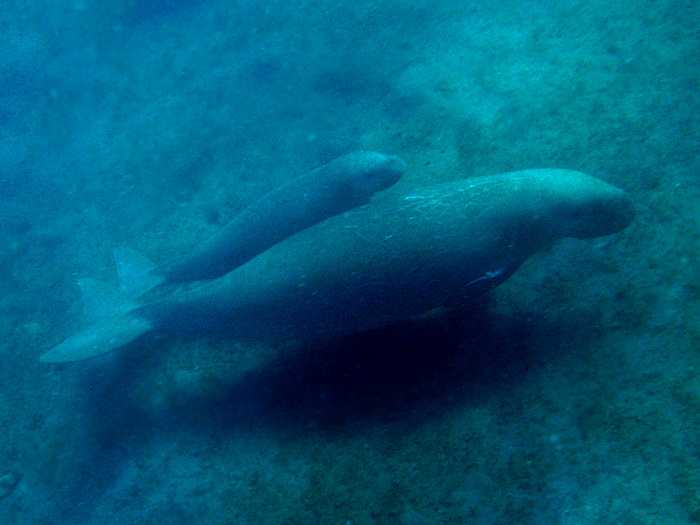The dugong is a marine mammal. It is one of four living species of the order Sirenia, which also includes three species of manatees. It is the only living representative of the once-diverse family Dugongidae; its closest modern relative, Steller’s sea cow (Hydrodamalis gigas), was hunted to extinction in the 18th century.
The dugong is the only sirenian in its range, which spans the waters of some 40 countries and territories throughout the Indo-West Pacific.
The dugong is largely dependent on seagrass communities for subsistence and is thus restricted to the coastal habitats which support seagrass meadows, with the largest dugong concentrations typically occurring in wide, shallow, protected areas such as bays, mangrove channels, the waters of large inshore islands and inter-reefal waters

Mama and baby dugong
Facts
The scientific name for a Dugong is Dugong dugon.
The dugong is a marine mammal
Dugongs are part of the Sirenia order of placental mammals which comprises modern “sea cows” like manatees
The word “dugong” derives from the Visayan word dugung
The dugong has been hunted for thousands of years for its meat and oil.
Dugongs have dull grey, torpedo-shaped bodies with paddle-like forelimbs, and a fluked tail like a dolphin. Mature males have tusks.
Dugongs lack dorsal fins and hind limbs.
Dugongs are referred to as “sea cows” because their diet consists mainly of seagrass.
Communication between individuals is through chirps, whistles, barks, and other sounds that echo underwater.
Dugongs are long-lived, and the oldest recorded specimen reached age 73
Other common local names include “sea cow”, “sea pig” and “sea camel”
When seagrass is scarce they may eat algae and sometimes even invertebrates like jellyfish, sea squirts and shellfish.
Today populations of dugongs are found in the waters of 37 countries and territories
Dugongs are not closely related to other marine mammals, being more related to elephants
Females tend to be larger than males
Their brains make up less than 1% of their body weight
The largest individual recorded was 4.06 metres long and weighed 1,016 kilograms
Weight in adults is typically more than 250 kilograms and less than 900 kilograms
Dugongs are found in warm coastal waters from the western Pacific Ocean to the eastern coast of Africa
Australia is home to the largest population, stretching from Shark Bay in Western Australia to Moreton Bay in Queensland
The population of Shark Bay is thought to be stable with over 10,000 dugongs
The Persian Gulf has the second-largest dugong population in the world, inhabiting most of the southern coast
Dugongs are social animals
Dugong are usually solitary or found in pairs due to the inability of seagrass beds to support large populations
They can go six minutes without breathing although about two and a half minutes is a more normal time
They can dive to a maximum depth of 39 metres; they spend most of their lives no deeper than 10 metres
When coming up for a breath of air, dugongs “stand” on their tails to support their heads above water.
Females give birth after a 13- to 15-month gestation, usually to just one calf
Newborns are already 1.2 metres long and weigh around 30 kilograms
The calf nurses for 14–18 months, although it begins to eat seagrasses soon after birth
Dugongs are thought to be the inspiration for ancient seafarer’s tales of mermaids and sirens.
